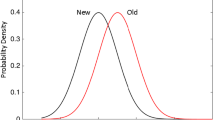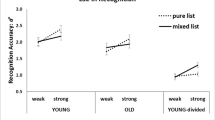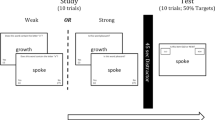Abstract
Surprisingly, response patterns in a recognition memory test are very similar regardless of whether the test list contains both targets and foils or just one class of items. To better understand these effects, we evaluate performance over the course of testing. Output interference (OI) is the decrease in performance across test trials due to an increase in noise caused by encoded test items. Critically, OI is predicted on pure lists if the mnemonic evidence for each test item is evaluated. In two experiments, participants received accurate feedback, no feedback, or random feedback that was unrelated to the response on each test trial and pure or standard test lists. When no feedback was provided, performance was nearly identical for standard and pure test lists, replicating previous findings. Only in the presence of accurate feedback were participants able to successfully adapt to pure list environments and improve their accuracy. Critically, OI was observed, demonstrating that participants continued to evaluate mnemonic evidence even in pure list conditions. We discuss the implication of these data for models of memory.



Similar content being viewed by others
Notes
Details including plots of individual-participant analyses are available by request.
We thank Ian Dobbins for this suggestion.
Note that the analysis of SDT parameters cannot be conducted for the pure list conditions, because an individual provides either an HR or an FAR but not both.
References
Annis, J., Malmberg, K. J., Criss, A. H., & Shiffrin, R. M. (2013). Sources of interference in recognition testing. Journal of Experimental Psychology: Learning, Memory, and Cognition, 39, 1365–1376.
Balota, D. A., Yap, M. J., Cortese, M. J., Hutchison, K. A., Kessler, B., Loftis, B., … Treiman, R. (2007). The English Lexicon Project. Behavior Research Methods, 39, 445–459.
Cox, J. C., & Dobbins, I. G. (2011). The striking similarities between standard, distractor-free, and target-free recognition. Memory & Cognition, 39, 925–940.
Criss, A. H. (2009). The distribution of subjective memory strength: List strength and response bias. Cognitive Psychology, 59, 297–319.
Criss, A. H., Kiliç, A., Malmberg, K. J., & Fontaine, J. (2014). Learning during study and test: A joint evaluation of list length effects and output interference. Manuscript in preparation.
Criss, A. H., & Koop, G. J. (in press). Differentiation in episodic memory. In J. Raaijmakers, A. H. Criss, R. Goldstone, R. Nosofsky, & M. Steyvers (Eds.), Cognitive modeling in perception and memory: A Festschrift for Richard M. Shiffrin. Psychology Press.
Criss, A. H., Malmberg, K. J., & Shiffrin, R. M. (2011). Output interference in recognition memory. Journal of Memory and Language, 64, 316–326.
Glanzer, M., Hilford, A., & Maloney, L. T. (2009). Likelihood ratio decisions in memory: Three implied regularities. Psychonomic Bulletin and Review, 16(3), 431–455. doi:10.3758/PBR.16.3.431
Green, D. M., & Swets, J. A. (1966). Signal detection theory and psychophysics. New York: Krieger.
Han, S., & Dobbins, I. G. (2008). Examining recognition criterion rigidity during testing using a biased-feedback technique: Evidence for adaptive criterion learning. Memory and Cognition, 36, 703–715.
Healy, A. F., & Kubovy, M. (1978). The effects of payoffs and prior probabilities on indices of performance and cutoff location in recognition memory. Memory & Cognition, 6, 544–553.
Hicks, J. L., & Starns, J. J. (2014). Strength cues and blocking at test promote reliable within-list criterion shifts in recognition memory. Memory & Cognition. doi:10.3758/s13421-014-0397-y
Kantner, J., & Lindsay, D. S. (2010). Can corrective feedback improve recognition memory? Memory & Cognition, 38, 389–406.
Kiliç, A. (2013). Output interference and strength based mirror effect in recognition memory (Doctoral dissertation). Retrieved from SURFACE Psychology-Dissertations.
Koop, G. J., & Criss, A. H. (2013). The response dynamics of recognition memory: Sensitivity and bias. Toronto, ONT: Poster session presented at the meeting of the Psychonomic Society.
Malmberg, K. J., & Annis, J. (2012). On the relationship between memory and perception: Sequential dependencies in recognition memory testing. Journal of Experimental Psychology: General, 141, 233–259.
Malmberg, K. J., Criss, A. H., Gangwani, T. H., & Shiffrin, R. M. (2012). Overcoming the negative consequences of interference from recognition memory testing. Psychological Science, 23, 115–119.
Mickes, L., Hwe, V., Wais, P. E., & Wixted, J. T. (2011). Strong memories are hard to scale. Journal of Experimental Psychology: General, 140, 239–257.
Murdock, B. B., Jr., & Anderson, R. E. (1975). Encoding, storage, and retrieval of item information. In Information processing and cognition: The Loyola symposium (pp. 145–194). Hillsdale, NJ: Erlbaum.
Ratcliff, R., Sheu, C. F., & Gronlund, S. D. (1992). Testing global memory models using ROC curves. Psychological Review, 99, 518–535.
Rhodes, M. G., & Jacoby, L. L. (2007). On the dynamic nature of response criterion in recognition memory: Effects of base rate, awareness, and feedback. Journal of Experimental Psychology: Learning, Memory, and Cognition, 33, 305–320.
Rotello, C. M., Macmillan, N. A., Hicks, J. L., & Hautus, M. J. (2006). Interpreting the effects of response bias on remember-know judgments using signal detection and threshold models. Memory & Cognition, 34, 1598–1614.
Starns, J. J., White, C. N., & Ratcliff, R. R. (2010). A direct test of the differentiation mechanism: REM, BCDMEM, and the strength-based mirror effect in recognition memory. Journal of Memory and Language, 63, 18–34.
Starns, J. J., White, C. N., & Ratcliff, R. (2012). The strength-based mirror effect in subjective strength ratings: The evidence for differentiation can be produced without differentiation. Memory & Cognition, 40, 1189–1199.
Treisman, M., & Williams, T. C. (1984). A theory of criterion setting with an application to sequential dependencies. Psychological Review, 91, 68–111.
Turner, B. M., Van Zandt, T., & Brown, S. (2011). A dynamic stimulus-driven model of signal detection. Psychological Review, 118, 583–613.
Wallace, W. P. (1982). Distractor-free recognition tests of memory. The American Journal of Psychology, 95, 421–440.
Acknowledgments
This material is partially based upon work supported by the National Science Foundation under grant number 0951612.
Author information
Authors and Affiliations
Corresponding author
Rights and permissions
About this article
Cite this article
Koop, G.J., Criss, A.H. & Malmberg, K.J. The role of mnemonic processes in pure-target and pure-foil recognition memory. Psychon Bull Rev 22, 509–516 (2015). https://doi.org/10.3758/s13423-014-0703-5
Published:
Issue Date:
DOI: https://doi.org/10.3758/s13423-014-0703-5




